Games Like Mario Vs Rabbids
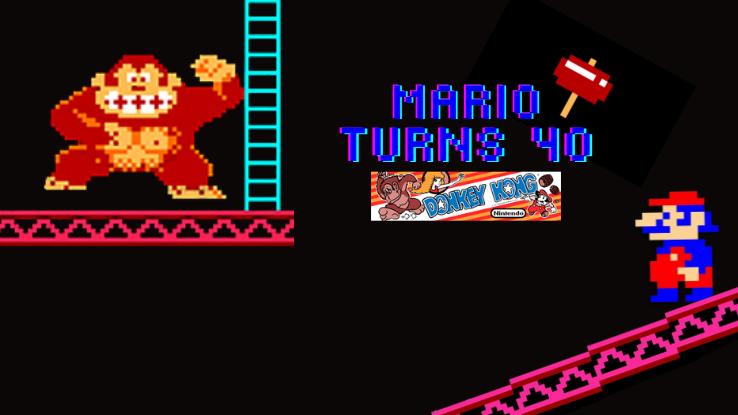
While Mario Bros., the first official installment in what would go the Mario multimedia franchise, made its way into arcades in 1983, Nintendo's now-flagship character really fabricated his on-screen debut 2 years earlier. In 1981, the Mario character came onto the scene in the arcade game Donkey Kong.
Yes, Mario is something of a spin-off character. And clearly that spin-off tactic proved successful for Nintendo: these days, the Mario franchise is the ninth highest-grossing multimedia franchise of all time. In fact, Nintendo'sPokémon, which is the highest-grossing multimedia franchise of all fourth dimension, is the only other video game-based franchise to crack the top 10.
Then, to celebrate Mario'south (and Donkey Kong'due south) 40th year in the pop culture zeitgeist, we're taking a wait back at the fire-tossing, high-jumping plumber that, against all odds, helped make Nintendo a household proper noun.
"Ass Kong" Launches Mario'due south Long-Running Career in 1981
Designed and directed by video game visionary Shigeru Miyamoto (Mario Bros., The Legend of Zelda), Donkey Kong was Nintendo's answer to Namco's incredibly popular Pac-Man (1980). In the platformer, gamers maneuver Mario around construction-site obstacles, all with the aim of rescuing Pauline — a forerunner to Princess Peach — from the clutches of Ass Kong, a giant, barrel-throwing gorilla.
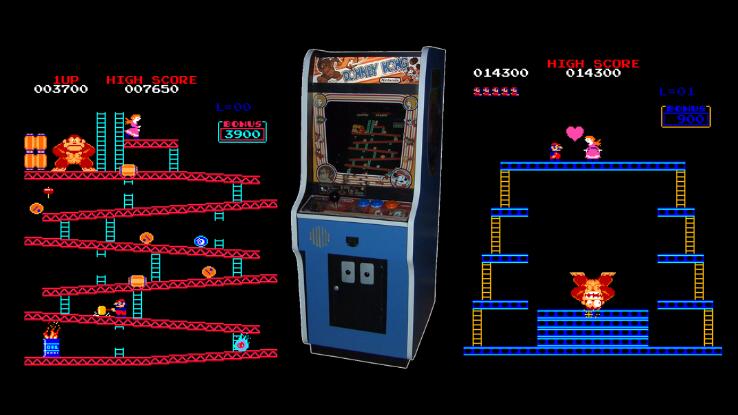
Of course, gamers might recall that Mario wasn't actually called Mario back in 1981: at the time, he was referred to as "Jumpman." Afterwards, the company dubbed him Mario, reportedly a reference to Nintendo of America's Italian American landlord, Mario Segale. Additionally, this so-chosen "everyman" character wasn't a plumber in his first outing, but a carpenter.
Notable for introducing several of Nintendo's central characters, Ass Kong is also a huge moment in gaming history for several other reasons. Not simply was information technology one of the very first platformers, only information technology was also the kickoff platform game to characteristic jumping — something that would become integral to the genre.
Much like Pac-Homo, Ass Kong relied on cutscenes to aid advance the game's sparse plot. And maybe, just mayhap, that'south partially why these characters resonated a bit more with gamers. Later on all, Nintendo has always composite innovation with solid gameplay and memorable characters and worlds, and Donkey Kong is an early example of the company'due south — and, in particular, Miyamoto'due south — successful formula.
Even if you lot're a more coincidental gamer, odds are you've played Super Mario Bros. at some indicate. The 1985 hit cemented Mario's identify equally the confront of Nintendo and, to a larger extent, ane of the industry's biggest icons. But before that ubiquitous classic came onto the scene, Mario also starred in a few other self-titled games: Mario'southward Cement Factory and Mario Bros., both of which debuted in 1983.
Commencement up, Mario'southward Cement Factory. Certainly the lesser-known of the 2 games, Cement Factory was released on Nintendo'south Game & Watch and developed by by Nintendo R&D1 nether Gunpei Yokoi, who produced and co-designed Donkey Kong alongside Miyamoto. In the game, players control Mario, helping him navigate a cement manufactory'southward elevators and funnels and save his co-workers from certain doom. While it'southward certainly one of the stranger entries in the Mario serial of games, Cement Factory was widely been praised, peculiarly given its complexity.
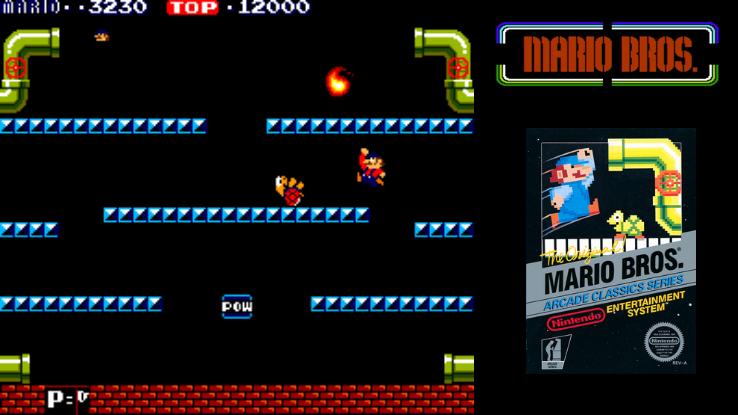
Of course, the more directly forerunner to Super Mario Bros. was the original Mario Bros., pictured here. Designed by both Miyamoto and Yokoi, Mario Bros. starred plumbers Mario and Luigi, the former's brother, every bit they work to exterminate the creatures emerging from New York City's sewers. This Donkey Kong spin-off certainly established many of the series about key elements, but, dissimilar time to come games, players aren't able to squash enemies by jumping on them. Instead, they have to flip enemies onto their backs and boot them off screen.
Released in arcades and for the Nintendo Entertainment System (NES; or Famicom), Mario Bros. came onto the scene during the video game crash of 1983, but, thanks to its memorable look and experience, information technology stood out — and, without a incertitude, marked the real beginnings of the series nosotros all know and love.
"Super Mario Bros." Changes the Game in 1985
Every bit we mentioned, when many of u.s. think of an old-school Mario game, Super Mario Bros. is what comes to listen. A successor to Mario Bros., Super Mario Bros. was released in 1985 in Nihon for Nintendo's Famicom and, later, got a limited release stateside on the NES. (A few years afterward, it would receive a wider release outside of Nihon.) Designed by Miyamoto and Takashi Tezuka, the game was dubbed a "grand culmination" of the team's tireless work.
In essence, it was the best of all things game pattern — and not only on a programming level. For example, the game's soundtrack, which was composed by Koji Kondo (The Fable of Zelda series), was a centerpiece of the game. (And, probable, one of the level's tracks is now looping in your head, right?) In improver to making side-scrollers all the more pop, Super Mario Bros. helped revive the entire industry and, with 50 million copies sold worldwide, it is one of the best-selling and all-time-reviewed video games of all fourth dimension.
In the game, players command Mario (or Luigi) as he searches the Mushroom Kingdom, eager to save Princess Toadstool (later on, Princess Peach) from King Koopa (later, Bowser). The game not merely introduced iconic enemies, from Goombas and Bullet Bills to Bowser himself, but it also served as the debut for a number of power-up items, including Super Mushrooms, Fire Flowers and Starman (colloquially dubbed Star Ability).
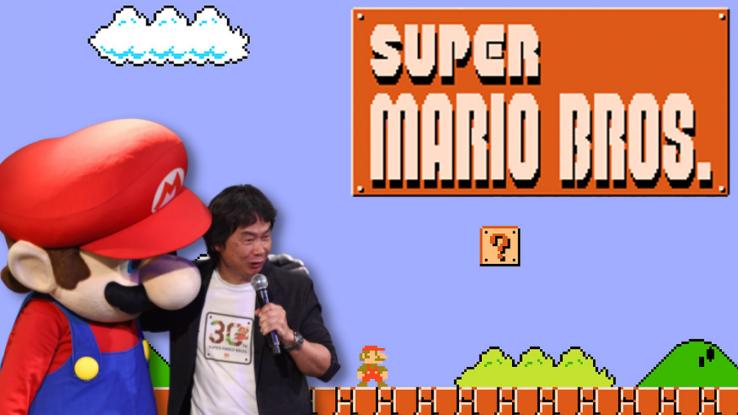
Of course, Mario'south mid- to late-80s success wasn't independent to just one game. In 1984, Mario was added to plenty of other Nintendo titles, including Tennis, in which Mario was the referee, equally well as Pinball, Golf, and Tetris, among many other Nintendo releases. This was non just a attestation to how well-loved the character was, merely it as well marked a smart move on Nintendo's role — the more gamers saw Mario, the more of a Mickey Mouse-level icon he'd go.
In 1989, Mario appeared in his own Game Boy game for the first time. AlthoughSuper Mario Landwas slightly dissimilar when information technology came to gameplay, fans still craved anything starring the plumber. A year later, Nintendo introduced Super Mario Bros. 3, a title that's often recognized as one of the franchise'south greatest of all fourth dimension — too as one of the greatest video games of all time.
In fact,Super Mario Bros. 3 became the third-all-time-selling NES game with more than 17 1000000 copies sold worldwide. The game introduced an overworld map and marked the first advent of the dearest Tanooki Suit. Several years later on, upon the release of the All-Stars edition of the game, Electronic Gaming Monthly ranked it second only to Tetris, writing that Super Mario Bros. 3 "took the series dorsum to its roots, but expanded upon the original game in every way imaginable. No other game since has been able to recapture the spirit of adventure and enchantment plant [here]."
In the '90s, Mario Broadens His Pursuits
The early '90s were the heyday of the Super Nintendo Entertainment System (SNES). In 1991, Super Mario World saw the titular graphic symbol facing off against Bowser and his Koopa army still again — though, this fourth dimension, it introduced Mario's lovable, light-green dino-pal Yoshi.
Of course, Nintendo didn't want to box Mario in. Or, mayhap more accurately, they wanted him everywhere. For case, players got the chance to run into Mario switching upwardly his profession in the puzzle game Dr. Mario (1990). In 1992, Mario saturday behind the wheel for the outset fourth dimension in the one-and-onlySuper Mario Kart — a game that would requite nativity to a long-running franchise (and miracle) in its own right. And, in 1996, Mario dipped his toes into the role-playing game (RPG) genre cheers toSuper Mario RPG: Legend of the Seven Stars, a articulation effort between Nintendo and Square (now, Square Enix), the visitor behind beloved RPG series similar Last Fantasy and Kingdom Hearts.
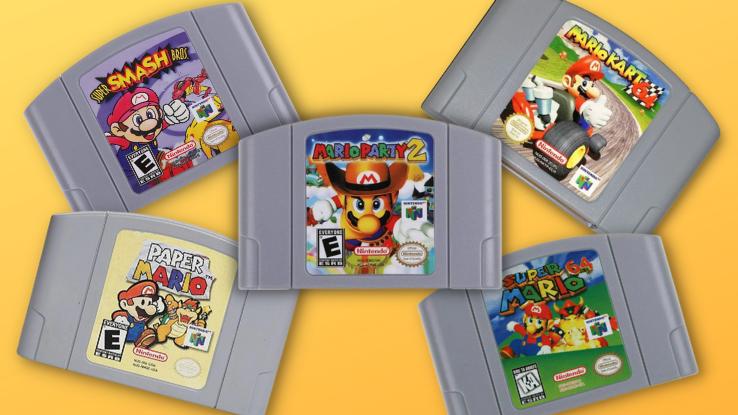
In the late '90s, the Nintendo 64 (N64) took Mario'southward adventures to new heights — technically speaking. Super Mario 64 (1996) marked the first "3D" Mario game; the open-world game allowed players to roam effectually a world equanimous mainly of 3D polygons. (Goodbye, side-scrolling and 2d sprites.) The effect? You really felt immersed in the various worlds of the game — and information technology brought the story and characters to life like never before.
The N64, which offered upwards four controller ports, certainly emphasized multi-role player and political party games. With an eye toward social gaming experiences, Nintendo released classics like Mario Kart 64 (1996) and launched several enduring (and honey) series, including Mario Party, Super Smash Bros., Mario Tennis and Mario Golf game, simply to name a few. Toward the stop of the N64'due south bicycle as the must-accept console, Nintendo released Paper Mario (2000), an innovative title that starred a paper cutting-out of Mario and mixed RPG, action-hazard and puzzling elements.
Mario Remains a Superstar Today
Over the adjacent few years, Nintendo would continue to release ever-innovative mainstays in the Mario franchise, from GameCube'due south odd-yet-artistic Super Mario Sunshine (2002) and Luigi'due south Mansion (2001) to the Wii'south gravity-defying Super Mario Galaxy (2007) and incredibly chaotic (nevertheless fun) New Super Mario Bros. Wii (2009) to the latest and greatest versions of Mario Kart, Super Blast, Mario Party, Paper Mario, and Mario [Insert Virtually Any Sport Here]. The WiiU's Super Mario Maker (2015) even allowed players to create their own side-scrolling adventures.
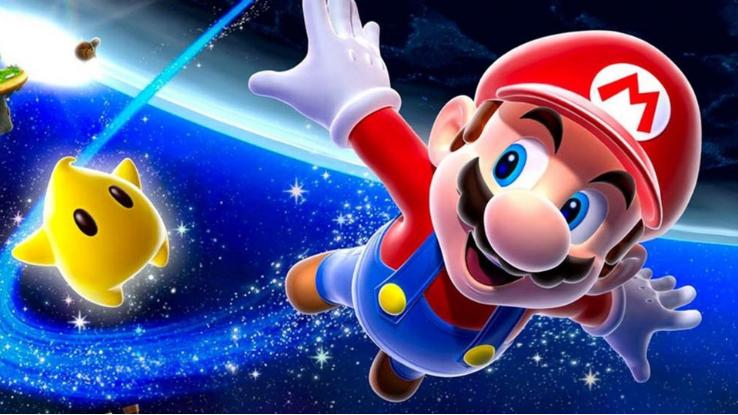
And, more recently, the Switch's Super Mario Odyssey (2017) gave players a hazard to embark on an open up-world, truly open-ended Mario adventure. As of March 2021,Odyssey has sold over 20 million copies, proving that connected innovation and a familiar, ruddy-capped hero can become a long style when information technology comes to appealing to gamers, fifty-fifty after 4 decades of fun. Mario sure has come a long way from his origins every bit Donkey Kong's Jumpman — and we tin't wait to see where his adventures bring us next.
Source: https://www.ask.com/culture/mario-turns-40-changed-gaming-forever?utm_content=params%3Ao%3D740004%26ad%3DdirN%26qo%3DserpIndex

0 Response to "Games Like Mario Vs Rabbids"
Post a Comment